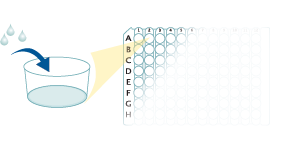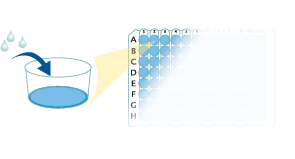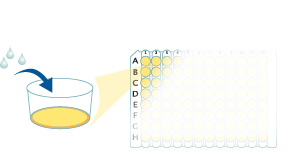Mouse Resistin Quantikine ELISA Kit Summary
Product Summary
Recovery
The recovery of mouse Resistin spiked to three levels throughout the range of the assay in various matrices was evaluated.
| Sample Type | Average % Recovery | Range % |
|---|---|---|
| Cell Culture Supernates (n=8) | 99 | 85-108 |
| EDTA Plasma (n=8) | 97 | 87-107 |
| Heparin Plasma (n=8) | 102 | 89-113 |
| Serum (n=6) | 99 | 93-108 |
Linearity
Scientific Data
Product Datasheets
Preparation and Storage
Background: Resistin
Resistin, also known ADSF and FIZZ3, is a secreted peptide hormone that circulates as either a noncovalent trimer, or a disulfide-linked homohexamer. Resistin is expressed by white adipocytes, splenocytes, astrocytes, and anterior pituitary epithelium. It blocks Insulin-stimulated uptake of glucose by adipocytes and promotes glucose release by hepatocytes. High circulating Insulin levels induce Resistin secretion which then antagonize Insulin action.
Assay Procedure
Refer to the product- Prepare all reagents, standard dilutions, and samples as directed in the product insert.
- Remove excess microplate strips from the plate frame, return them to the foil pouch containing the desiccant pack, and reseal.
- Add 50 µL of Assay Diluent to each well.
- Add 50 µL of Standard, Control, or sample to each well. Cover with a plate sealer, and incubate at room temperature for 2 hours on a horizontal orbital microplate shaker.
- Aspirate each well and wash, repeating the process 4 times for a total of 5 washes.
- Add 100 µL of Conjugate to each well. Cover with a new plate sealer, and incubate at room temperature for 2 hours on the shaker.
- Aspirate and wash 5 times.
- Add 100 µL Substrate Solution to each well. Incubate at room temperature for 30 minutes on the benchtop. PROTECT FROM LIGHT.
- Add 100 µL of Stop Solution to each well. Read at 450 nm within 30 minutes. Set wavelength correction to 540 nm or 570 nm.





Citations for Mouse Resistin Quantikine ELISA Kit
R&D Systems personnel manually curate a database that contains references using R&D Systems products. The data collected includes not only links to publications in PubMed, but also provides information about sample types, species, and experimental conditions.
20
Citations: Showing 1 - 10
Filter your results:
Filter by:
-
Blockade of CXXC5-dishevelled interaction inhibits adipogenic differentiation, obesity, and insulin resistance in mice
Authors: SH Seo, D Lee, SH Lee, KY Choi
Scientific Reports, 2022-11-30;12(1):20669.
Species: Mouse
Sample Types: Serum
-
Discovery of a potent GIPR peptide antagonist that is effective in rodent and human systems
Authors: B Yang, VM Gelfanov, K El, A Chen, R Rohlfs, B DuBois, AM Kruse Hans, D Perez-Tilv, PJ Knerr, D D'Alessio, JE Campbell, JD Douros, B Finan
Molecular Metabolism, 2022-11-15;0(0):101638.
Species: Mouse
Sample Types: Serum
-
REDD1 promotes obesity-induced metabolic dysfunction via atypical NF-kappaB activation
Authors: DK Lee, T Kim, J Byeon, M Park, S Kim, J Kim, S Choi, G Lee, C Park, KW Lee, YJ Kwon, JH Lee, YG Kwon, YM Kim
Nature Communications, 2022-10-22;13(1):6303.
Species: Mouse
Sample Types: Plasma
-
Polygonatum sibiricum F. Delaroche polysaccharide ameliorates HFD?induced mouse obesity via regulation of lipid metabolism and inflammatory response
Authors: B Liu, Y Tang, Z Song, J Ge
Molecular Medicine Reports, 2021-05-13;24(1):.
Species: Mouse
Sample Types: Plasma
-
Prostaglandin E2-EP4 Axis Promotes Lipolysis and Fibrosis in Adipose Tissue Leading to Ectopic Fat Deposition and Insulin Resistance
Authors: T Inazumi, K Yamada, N Shirata, H Sato, Y Taketomi, K Morita, H Hohjoh, S Tsuchiya, K Oniki, T Watanabe, Y Sasaki, Y Oike, Y Ogata, J Saruwatari, M Murakami, Y Sugimoto
Cell Rep, 2020-10-13;33(2):108265.
Species: Mouse
Sample Types: Serum
-
Depletion of B cell-activating factor attenuates hepatic fat accumulation in a murine model of nonalcoholic fatty liver disease
Authors: Y Nakamura, M Abe, K Kawasaki, T Miyake, T Watanabe, O Yoshida, M Hirooka, B Matsuura, Y Hiasa
Sci Rep, 2019-01-30;9(1):977.
Species: Mouse
Sample Types: Serum
-
Leptin Production by Encapsulated Adipocytes Increases Brown Fat, Decreases Resistin, and Improves Glucose Intolerance in Obese Mice
Authors: DJ DiSilvestr, E Melgar-Ber, R Yasmeen, P Fadda, LJ Lee, A Kalyanasun, CL Gilor, O Ziouzenkov
PLoS ONE, 2016-04-07;11(4):e0153198.
Species: Mouse
Sample Types: Plasma
-
sigma1B adaptin regulates adipogenesis by mediating the sorting of sortilin in adipose tissue.
Authors: Baltes J, Larsen J, Radhakrishnan K, Geumann C, Kratzke M, Petersen C, Schu P
J Cell Sci, 2014-06-13;127(0):3477-87.
Species: Mouse
Sample Types: Serum
-
PKClambda haploinsufficiency prevents diabetes by a mechanism involving alterations in hepatic enzymes.
Authors: Sajan M, Ivey R, Lee M, Mastorides S, Jurczak M, Samuels V, Shulman G, Braun U, Leitges M, Farese R
Mol Endocrinol, 2014-05-30;28(7):1097-107.
Species: Mouse
Sample Types: Serum
-
Induction of adipocyte hyperplasia in subcutaneous fat depot alleviated type 2 diabetes symptoms in obese mice.
Authors: Lu Q, Li M, Zou Y, Cao T
Obesity (Silver Spring), 2014-02-11;22(7):1623-31.
Species: Mouse
Sample Types: Serum
-
Ox-LDL induces ER stress and promotes the adipokines secretion in 3T3-L1 adipocytes.
Authors: Chen Y, Chen M, Wu Z, Zhao S
PLoS ONE, 2013-11-22;8(10):e81379.
Species: Mouse
Sample Types: Cell Culture Supernates
-
Tangeretin stimulates glucose uptake via regulation of AMPK signaling pathways in C2C12 myotubes and improves glucose tolerance in high-fat diet-induced obese mice.
Mol. Cell. Endocrinol., 2012-03-28;358(1):127-34.
Species: Mouse
Sample Types: Serum
-
HCV core-induced nonobese hepatic steatosis is associated with hypoadiponectinemia and is ameliorated by adiponectin administration.
Authors: Chang ML, Yeh HC, Tsou YK
Obesity (Silver Spring), 2012-02-23;20(7):1474-80.
Species: Mouse
Sample Types: Serum
-
Castration-induced changes in mouse epididymal white adipose tissue.
Authors: Floryk D, Kurosaka S, Tanimoto R, Yang G, Goltsov A, Park S, Thompson TC
Mol. Cell. Endocrinol., 2011-07-12;345(1):58-67.
Species: Mouse
Sample Types: Serum
-
eNOS plays a major role in adiponectin synthesis in adipocytes.
Authors: Koh EH, Kim M, Ranjan KC, Kim HS, Park HS, Oh KS, Park IS, Lee WJ, Kim MS, Park JY, Youn JH, Lee KU
Am. J. Physiol. Endocrinol. Metab., 2010-02-02;298(4):E846-53.
Species: Mouse
Sample Types: Plasma
-
PPARgamma in the endothelium regulates metabolic responses to high-fat diet in mice.
Authors: Kanda T, Brown JD, Orasanu G, Vogel S, Gonzalez FJ, Sartoretto J, Michel T, Plutzky J
J. Clin. Invest., 2008-12-08;119(1):110-24.
Species: Mouse
Sample Types: Serum
-
Regulation of the brown and white fat gene programs through a PRDM16/CtBP transcriptional complex.
Authors: Kajimura S, Seale P, Tomaru T, Erdjument-Bromage H, Cooper MP, Ruas JL, Chin S, Tempst P, Lazar MA, Spiegelman BM
Genes Dev., 2008-05-15;22(10):1397-409.
Species: Mouse
Sample Types: Cell Culture Supernates
-
Role and regulation of adipokines during zymosan-induced peritoneal inflammation in mice.
Authors: Pini M, Gove ME, Sennello JA, van Baal JW, Chan L, Fantuzzi G
Endocrinology, 2008-05-01;149(8):4080-5.
Species: Mouse
Sample Types: Serum
-
Octylphenol stimulates resistin gene expression in 3T3-L1 adipocytes via the estrogen receptor and extracellular signal-regulated kinase pathways.
Authors: Lee MJ, Lin H, Liu CW, Wu MH, Liao WJ, Chang HH, Ku HC, Chien YS, Ding WH, Kao YH
Am. J. Physiol., Cell Physiol., 2008-04-16;294(6):C1542-51.
Species: Mouse
Sample Types: Serum
-
Neuropeptide Y acts directly in the periphery on fat tissue and mediates stress-induced obesity and metabolic syndrome.
Authors: Kuo LE, Kitlinska JB, Tilan JU, Li L, Baker SB, Johnson MD, Lee EW, Burnett MS, Fricke ST, Kvetnansky R, Herzog H, Zukowska Z
Nat. Med., 2007-07-01;13(7):803-11.
Species: Mouse
Sample Types: Plasma
FAQs
No product specific FAQs exist for this product, however you may
View all ELISA FAQsReviews for Mouse Resistin Quantikine ELISA Kit
There are currently no reviews for this product. Be the first to review Mouse Resistin Quantikine ELISA Kit and earn rewards!
Have you used Mouse Resistin Quantikine ELISA Kit?
Submit a review and receive an Amazon gift card.
$25/€18/£15/$25CAN/¥75 Yuan/¥2500 Yen for a review with an image
$10/€7/£6/$10 CAD/¥70 Yuan/¥1110 Yen for a review without an image





